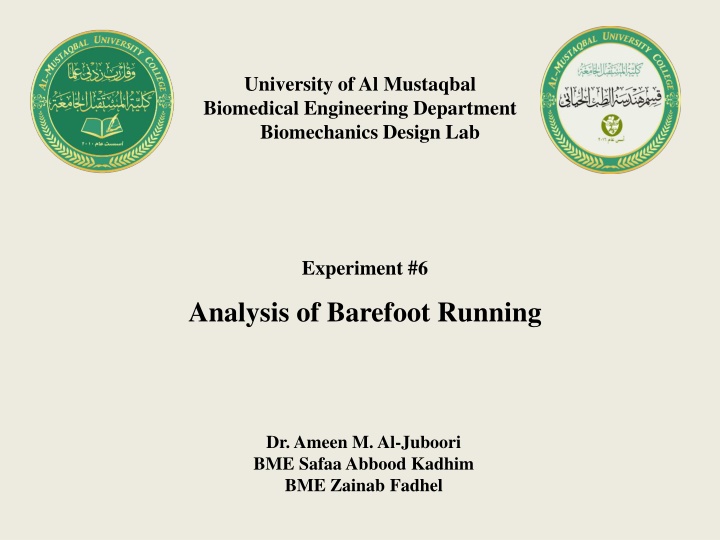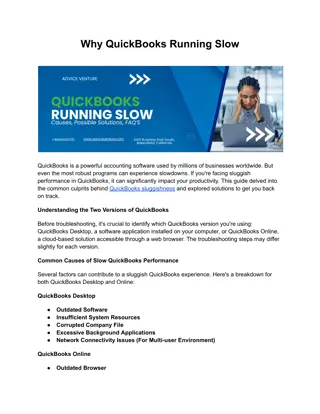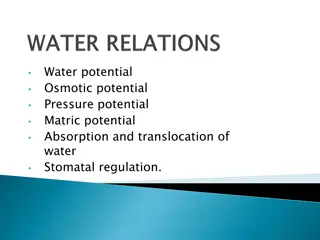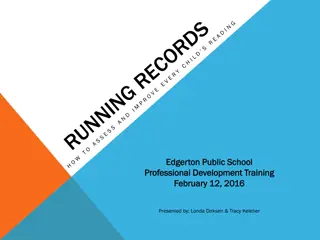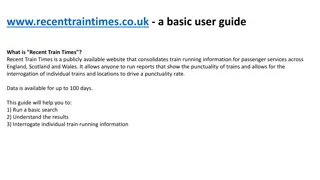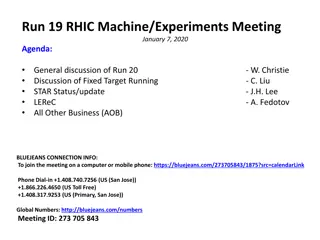Analysis of Barefoot Running: Effects and Potential Benefits
This experiment delves into the impact of barefoot running on cadence and explores the potential benefits and harms associated with this running style. Discover how barefoot running can affect musculoskeletal health and overall running economy.
Download Presentation

Please find below an Image/Link to download the presentation.
The content on the website is provided AS IS for your information and personal use only. It may not be sold, licensed, or shared on other websites without obtaining consent from the author.If you encounter any issues during the download, it is possible that the publisher has removed the file from their server.
You are allowed to download the files provided on this website for personal or commercial use, subject to the condition that they are used lawfully. All files are the property of their respective owners.
The content on the website is provided AS IS for your information and personal use only. It may not be sold, licensed, or shared on other websites without obtaining consent from the author.
E N D
Presentation Transcript
University of Al Mustaqbal Biomedical Engineering Department Biomechanics Design Lab Experiment #6 Analysis of Barefoot Running Dr. Ameen M. Al-Juboori BME Safaa Abbood Kadhim BME Zainab Fadhel
Introduction This experiment is designed investigate the effects barefoot running; a running trend popularized by Christopher McDougall in the book Born to Run. Traditional running technique emphasizes a heel-to- toe foot strike during each stride. Without the padding provided by traditional running shoes, barefoot running tends to minimize heel strike. This often leads to a change in the step rate of the barefoot runner. Cadence is another word that is commonly used for step rate. Cadence is defined as the number of steps a subject takes per minute.
A pedometer is a device that can be used to monitor steps and step rate. As a result, used to measure cadence when walking or running. The Go Direct Respiration Belt built in pedometer that will be used in this experiment. The Go Direct Respiration Belt will be attached to the subject who will run for a brief period of time while wearing normal running shoes. The subject will then repeat the test while running barefoot. The mean cadence in steps per minute (spm) will then be determined for both conditions. The subsequent data will be used determine barefoot running changes the cadence of the subject. a pedometer can be
Bare foot Running The human foot is designed that the toes are spread and extended. In well-developed natural shape has been changed footwear which the heel forefoot, the toes become elevated and pinched together over time. This deforms the foot, and leads to the foot problems, musculoskeletal pathologies. Several researches supported the claims that going barefoot was healthy and Natural , Barefoot running, minimalist running and natural running are all terms that describe running in a manner that allows the foot to function the way it is designed. societies, the foot s by long wearing is elevated above the gait abnormalities,
The potential benefits of barefoot running 1. Reduction of ground reaction forces Barefoot running reduced impact force when Performed number of steps. 2-increased running economy; Burkett et al. (1985) found that oxygen consumption during running increased as the amount of mass they added to the foot. 3- Increased proprioceptive input; It has been suggested that footwear material densities affected periphearal sensory information. 4. Increased muscle strength; Rao and Joseph (1992) evaluated 2,300 Indian children between the ages of 4 and 13 and found that the incidence of flat feet was more than three times greater in shod than in unshod. 5. Decreased risk of foot deformities on a sufficient
The potential harms of barefoot running 1. Injuries from running surfaces; The skin of the foot is exposed to debris such as glass, nails, rocks and thorns and have a chance to injure.. 2. Exposure to microorganisms/infectious agents; Cracks, blisters, or scrapes on the feet will have a higher risk of infection. 3. Lack of support; Less cushioning and a thinner heel shoes should be used with caution and awareness of the possible increased injury risks. 4. Poor running pattern; causes muscle strains
Running Injuries Many injuries are related to running because of the high impact forces. Since recreational running becomes dramatically popular among people, the incidence of running injuries has risen. Several literatures indicated that the etiology of running- related injuries was multi factorial characteristic Most of the running injuries are overuse injuries which occur as a result of repetitive microtrauma from chronic loading of tendons, muscles, or bones.
The factors that causing running injuries could be categorized into three factors: The training factors have been routine excessive mileage, increased intensity, duration and frequency of running, irregular experiences, orthotic use, the type of shoe insoles, incorrect footwear, training errors. The anatomical factors have been identified as the abnormalities or malalignment of the body, especially lower extremities such as tibia varum, rear foot varus. The biomechanical factors have been the magnitude of impact forces. surface running, running
